 Today people all around the world are commemorating Christ’s suffering on the cross and in Medieval and Tudor times people would attend a ceremony known as “Creeping to the Cross”. The suffering of Christ was commemorated by the clergy creeping, on their hands and knees, up to a crucifix held up before the altar. After they had crept up to the cross they would kiss the feet of Christ before the crucifix was then taken down for the congregation to do the same.
Today people all around the world are commemorating Christ’s suffering on the cross and in Medieval and Tudor times people would attend a ceremony known as “Creeping to the Cross”. The suffering of Christ was commemorated by the clergy creeping, on their hands and knees, up to a crucifix held up before the altar. After they had crept up to the cross they would kiss the feet of Christ before the crucifix was then taken down for the congregation to do the same.
But it wasn’t just the clergy who carried out this special ritual, monarchs would also get down on their hands and knees, creep to the cross and then bless metal in a dish by the altar with holy water. The blessed metal would then be made into cramp rings, rings that were supposed to alleviate cramp and “falling sickness”, or epilepsy. It was believed that the monarch had supernatural qualities as successors of Edward the Confessor and God’s anointed sovereign. “Touching for the King’s evil” was also carried out on this day, again because of the curative powers of the monarch’s touch.
Marco Antionio Faitta, the Venetian Ambassador, described Mary I’s Easter rituals in 1556, recording that she washed the feet of 41 poor women on Maundy Thursday, gave alms and gifts and then, on Good Friday, crept to the cross before blessing those afflicted with scrofula, a type of Tuberculosis:-
“But she chose to perform this act privately in a gallery where there were not above twenty persons. She caused one of the infirm women to be brought to her, when she knelt and pressed with her hands on the spot where the sore was. This she did to a man and three women. She then made the sick people come up to her again, and taking a gold coin – viz. an angel – she touched the place where the evil showed itself, signed it with the Cross and passed a ribbon through the hole which had been pierced in it, placing one of them round the neck of each of the patients, and making them promise never to part with that coin, save in case of extreme need.”
Faitta then goes on to describe Mary’s “humility and love of religion” as she carried out these traditional Easter rituals.
Good Friday was also the day to prepare the Easter Sepulchre, a wooden or stone niche which represented Christ’s sealed tomb and which was filled with an image of Christ and the consecrated Host. The sepulchre would then be ‘sealed’ with a cloth and candles lit around it, and members of the church would guard it to represent the Roman soldiers who guarded Christ’s tomb.
Notes and Sources
- “Would I Could Give You Help and Succour”: Elizabeth I and the Politics of Touch, Carole Levin, University of Nebraska, 1989, Published in ALBION: A QUARTERLY JOURNAL CONCERNED WITH BRITISH STUDIES, Vol. 21, No. 2 (Summer, 1989), p197
- Pleasures and Pastimes in Tudor England, Alison Sim